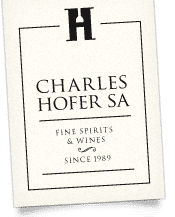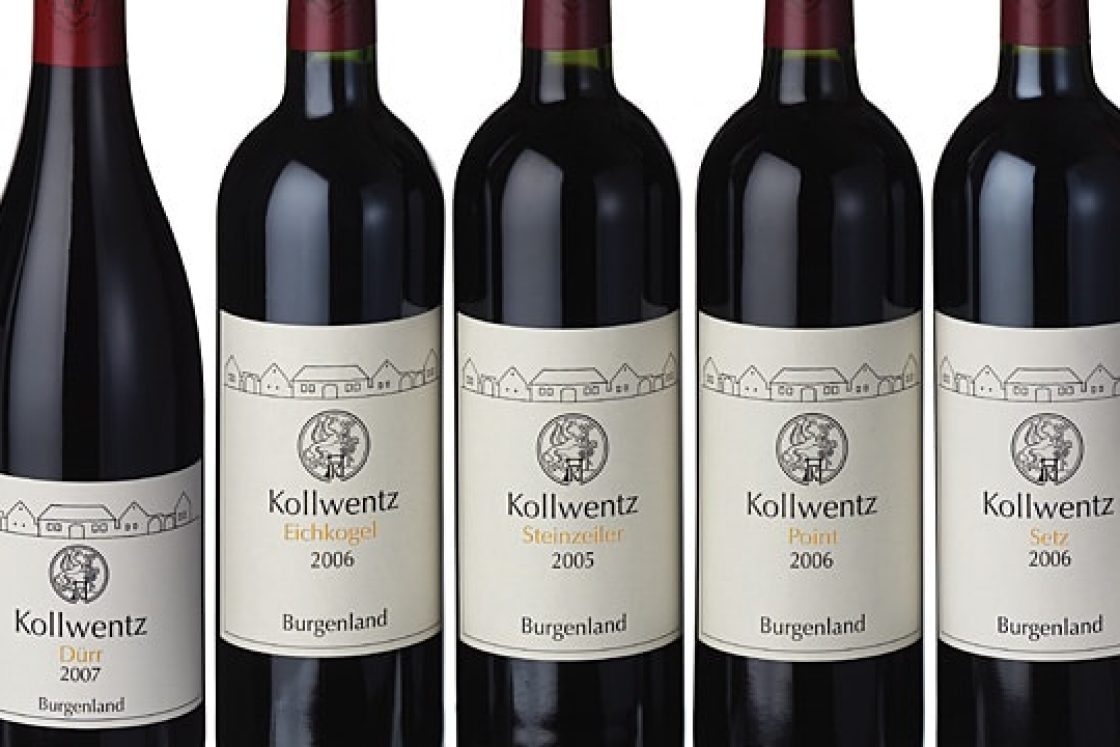Kollwentz Winery – Römerhof
Grosshöflein, Burgenland
A Vintner Dynasty
When a vineyard, such as the Kollwentz winery in Grosshöflein, has been in the family since 1775, the designation ‘dynasty’ seems appropriate. The location on the south facing slopes of the Leitha Mountains is one of the best and oldest in the country. Resounding names like Steinzeiler, Point, Dürr, Tatschler, Gloria, and Setz were mentioned as vineyard sites as early as the years 1569 and 1570. Here, the Kollwentz family maintains the vineyard concept in its purest form: their own vineyards, their own grapes, and their own wine.
Vineyards on the south facing slopes of the Leitha Mountains have been in operation since Celtic times, and they contain the earliest evidence of viniculture in central Europe. Grape seeds found in Zagersdorf have been dated to 700 B.C.
Andi Kollwentz – a decathlete among Austria’s vintners
Beginning with the 1993 vintage, Andi Kollwentz has taken over responsibilities of the cellar. Since 2004, Andi and Heidi Kollwentz are in charge of the operation of the winery.
“The location determines the type of vine” is Andi Kollwentz’s doctrine. Only under ideal conditions can vines produce grapes that reach optimal maturity – which is the basis for great wines.
Peter Moser of Falstaff Magazine adds: “Andi Kollwentz is a decathlete among Austria’s vintners because he has mastered a broad range of disciplines and ranks among the top vintners in every wine category, whether white, red, or sweet.”
White Wines
At the Kollwentz winery, the Chardonnay grape vine is the most prevalent among the white varieties. Its cultivation was predestined by nature with a broad selection of soils and locations: Tatschler, Gloria, Neusatz, Kreuzweingärten, Perisch, and Torwartl.
Chardonnay is a venerable variety that has been cultivated in the area around Lake Neusiedl for more than 100 years. Locations around the world that produce the best Chardonnay wines have one feature in common: limestone. The Leitha Mountains are thus part of an illustrious group of wine regions that includes the Champagne, the Chablis, and the Côte d‘Or (Burgundy).
Tatschler
The first documented mention of the Tatschler vineyard dates from 1570. Cultivated on the southeastern, wind-protected slopes of the Leitha Mountains, the Chardonnay ripens to the highest quality on weathered limestone and slate soils. Fermented and aged in small oak barrels, the wine is captivating with its full aroma of fruit, its robust flavor, and elegance. Chardonnay Tatschler is a sophisticated and versatile accompaniment to a variety of dishes. It is best paired with seafood or shellfish, pasta, and white meat.
Gloria
First records of the Gloria vineyard, the highest elevation vineyard of the Leitha Mountains, date from 1570. The cooler temperatures of the bordering forest and the meager quality of the shell limestone soil result in a slower and longer ripening process of the grapes. A distinct mineral quality and finesse characterize this wine. Chardonnay Gloria goes well with seafood and shellfish, as well as pasta dishes.
Chardonnay Leitha Mountains / from the vineyards
Since time immemorial, Burgenland has been the home of Chardonnay, also known as Klevner. The best wines are produced from soils rich in limestone, and these can be found in the Leitha Mountains. Combined with the Pannonian climate, the region produces a full-bodied, elegant wine with a delicate hint of spice. The Chardonnay is ideally paired with shellfish, fish, and white meat.
Steinmühle (Stone Mill) Sauvignon blanc
Sauvignon blanc is a venerable variety in Burgenland. It is considered to be the most challenging grape vine in general, and is particularly sensitive to location. It does best in igneous rock soils like flint/silex, and these can be found in the Steinmühle vineyard site. The soil, in combination with the Pannonian climate of Burgenland, produces expressive and striking wines. Only a handful of our own grape vines are used to propagate the Sauvignon blanc to ensure its high quality and unadulterated character. The full aroma of this Sauvignon ranges from bell peppers, over elderberry blossoms, to passion fruit. It is best paired with seafood dishes, asparagus, and white meat.
Red Wines
True to tradition, Blaufränkisch and Zweigelt dominate the cultivation of red wine in Burgenland. At the Kollwentz winery, the venerable variety, Blaufränkisch, grows in the historic vineyard sites of ‘Point’ and ‘Setz’. They are bottled as single vineyard wines, and, due to their robust flavors and spiciness, also form the backbone of the top cuvée ‘Steinzeiler’. Wine pioneer Anton Kollwentz was instrumental in the propagation of Zweigelt in Burgenland, and was the first vintner to cultivate Cabernet Sauvignon in Austria.
Steinzeiler
Steinzeiler was named after the rocky, limestone-rich soils of the southern slopes of the Leitha Mountains. Grape vines have been growing in these locations for 2800 years. Steinzeiler –vinified from 60 – 80 % Blaufränkisch from the vineyard sites of Point and Setz, Cabernet Sauvignon, and Zweigelt – is a robust red wine with elegance and charm from meticulously maintained, old grape vines. Steinzeiler is the perfect accompaniment to wild game, dark meat, and cheese. Younger vintages should be opened or decanted just a few hours prior to serving.
Point
1570 marks the first recorded mention of the vineyard, Point. The Kollwentz family has owned this parcel of the former estate of the Hungarian noble family, Esterházy, since 1848.
Directly south facing slopes, coupled with calcareous loamy soils, produce a small harvest of Blaufränkisch that is full of character and rich in extracts year after year. This special Blaufränkisch is captivating through its wonderful blackberry fruit aroma and robust spiciness. It is the universal accompaniment to pâtés and meat dishes. Younger vintages should be opened or decanted just a few hours prior to serving.
Setz
The vineyard site, ‘Krapflried’ which had its first entry in manuscripts dated from 1570, is commonly referred to as ‘Setz’. Stretching into the direction of Kleinhöflein, it borders the vineyards of Grosshöflein. In light of its southeastern facing slopes, the vineyard enjoys full sun from early morning until late afternoon. In the ‘Setz’ vineyard, Blaufränkisch grapes attain optimal ripeness. This special Blaufränkisch of the Kollwentz estate impresses with its fine cherry and licorice aroma, as well as its robust spice tones. It is best paired with grilled meats. Younger vintages should be opened or decanted just a few hours prior to serving.
Dürr
The first documented mention of the ‘Dürr’ vineyard site also dates back to 1570. Given the elevation of the vineyard and the cooler temperatures generated by the surrounding forest, Pinot Noir grapes cultivated here reach their maturity through a slow ripening process. A distinct mineral quality and finesse characterize this Pinot grown in shell limestone soil.
Cabernet Sauvignon
Cabernet Sauvignon is the most widely distributed grape vine for red wine in the world. The Pannonian climate of the Burgenland ensures that it attains the highest quality. With a yield of approximately 30 hectoliters per hectare, the result is an elegant wine rich in extract. The wine is aged in small oak barrels and attains its optimal drinkability after five to seven years. This Cabernet develops an impressive bouquet of cassis with a soft hint of vanilla. Cabernet Sauvignon is the perfect accompaniment to wild game, beef, and cheese. Younger vintages should be opened or decanted just a few hours prior to serving.
Eichkogel
Eichkogel is a cuvée made from the traditional Grosshöflein varieties of Blaufränkisch (70%) and Zweigelt (30%). In the Pannonian climate of the Burgenland, the grapes on the south facing slopes of the Leitha Mountains ripen to the highest degree and quality. Matured in small oak barrels, the Eichkogel combines the spicy berry aroma of the Blaufränkisch with the velvety smoothness of the Zweigelt. Eichkogel is an excellent choice for flavorful meat dishes like lamb or steaks. Younger vintages should be opened or decanted just a few hours prior to serving.
Blaufränkisch Leitha Mountains
Blaufränkisch is the celebrated grape vine for the red wine of Burgenland. Grown in the Pannonian climate and in limestone-containing loamy soils of the Leitha Mountains, the Blaufränkisch attains the highest quality. After it has been aged in oak barrels, it is bottled unfiltered. This Blaufränkisch has a captivating aroma of berry and elegant spice.
Zweigelt Föllikberg
Zweigelt is a hybrid of Blaufränkisch and St. Laurent. It was first cultivated in 1922 by its namesake, Professor Zweigelt. On account of its high quality, Zweigelt is the only new variety that has been able to secure its place among Austria’s vine specialties. With its elegant character and sour cherry aroma, Zweigelt can be enjoyed as early as the year following harvest. It is ideally paired with grilled dishes, pork, and lamb.


